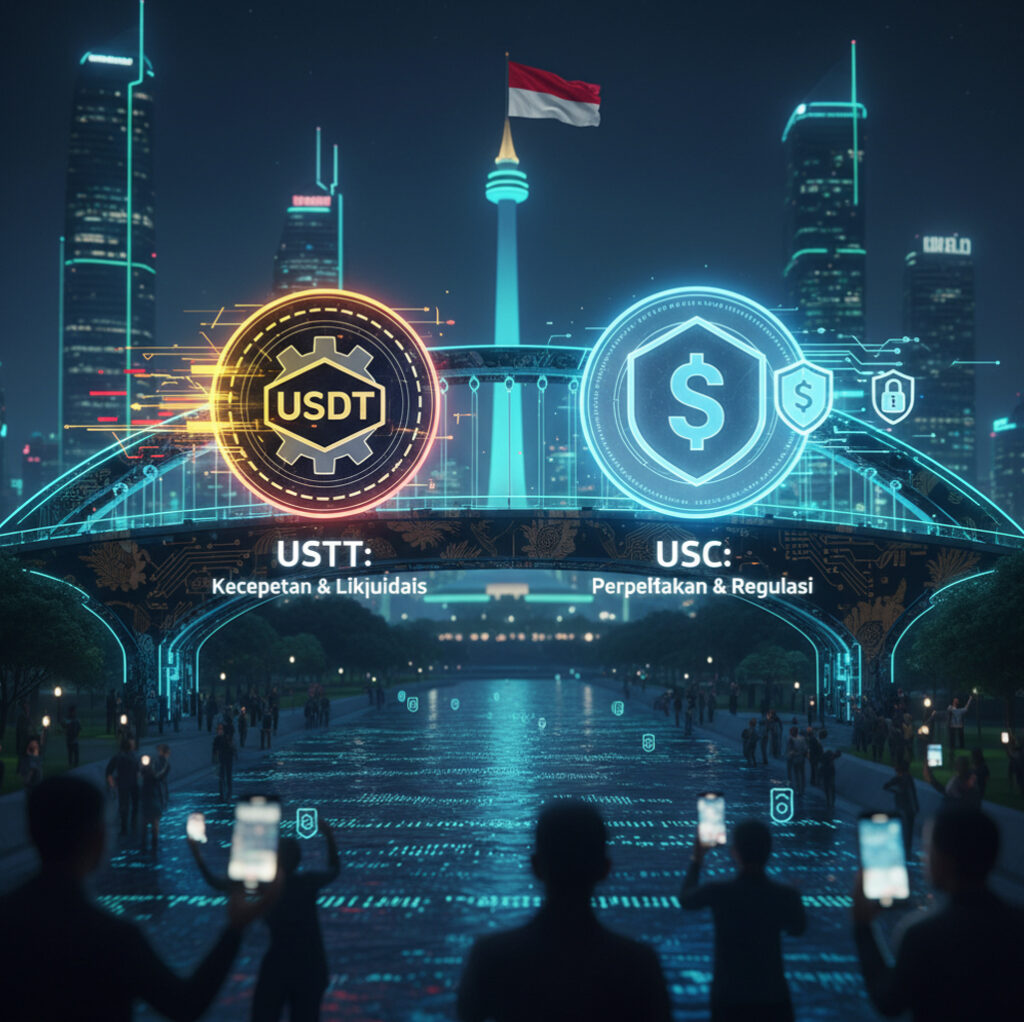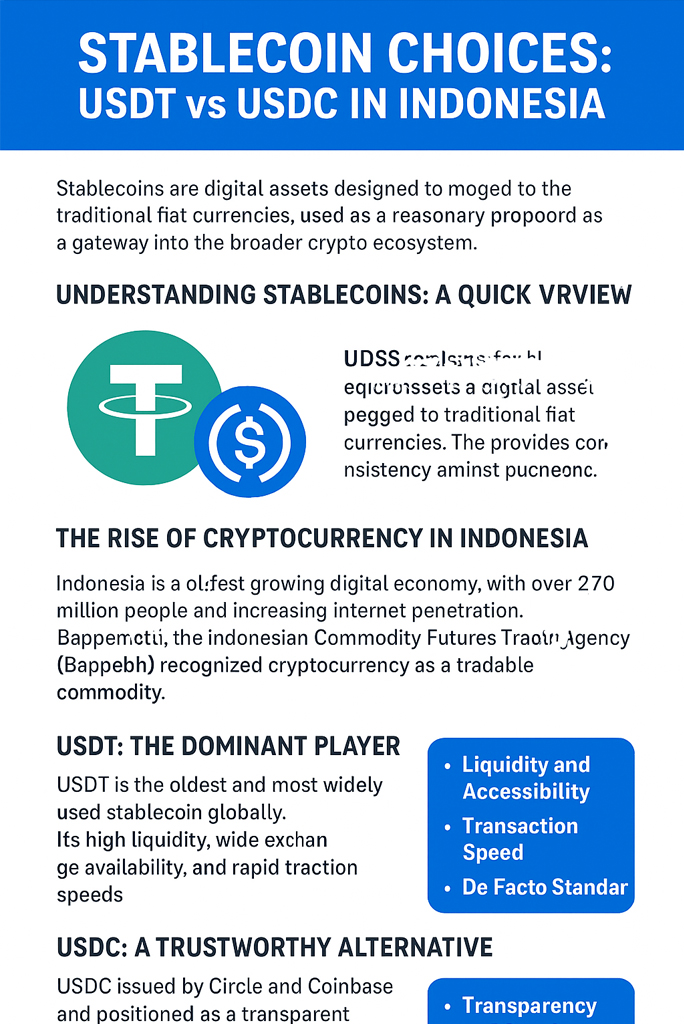Premium Biz Post – In recent years, cryptocurrency adoption in Southeast Asia has seen remarkable growth, with Indonesia emerging as one of the region’s most dynamic markets. Among the various digital assets gaining attention, stablecoins are leading the way, providing users with a reliable store of value and a gateway into the broader crypto ecosystem. Stablecoin Choices: USDT vs USDC in Indonesia highlights the increasing role of these two digital currencies as Indonesians explore safer ways to engage with crypto markets.

Understanding Stablecoins: A Quick Overview
Stablecoins are digital assets designed to maintain a stable value by pegging themselves to traditional fiat currencies, usually the US Dollar. They are crucial in a market known for volatility, offering traders and investors a way to hedge against sudden price swings. Unlike Bitcoin or Ethereum, which can fluctuate drastically, stablecoins are meant to provide consistency, making them appealing to individuals and businesses seeking reliability in transactions and cross-border payments.
In Indonesia, a country where interest in cryptocurrency continues to rise, stablecoins like Tether (USDT) and USD Coin (USDC) have become popular tools for both seasoned investors and newcomers. Their adoption is being driven by factors such as inflation concerns, limited access to traditional banking services, and the growing digital economy.
The Rise of Cryptocurrency in Indonesia
Indonesia has one of the fastest-growing digital economies in the world. With over 270 million people and increasing internet penetration, the demand for accessible financial solutions is on the rise. The Indonesian Commodity Futures Trading Regulatory Agency (Bappebti) has recognized cryptocurrency as a tradable commodity, allowing users to invest in and trade crypto legally through licensed exchanges.
The government has implemented regulations aimed at ensuring investor protection while fostering innovation in the crypto space. As part of this push, stablecoins have been seen as a safer entry point for retail traders wary of Bitcoin or Ethereum’s volatility. Licensed exchanges such as Pintu, Indodax, and Tokocrypto have made stablecoins widely available, giving Indonesians convenient access to both USDT and USDC.
USDT: The Dominant Player
Tether (USDT) is the oldest and most widely used stablecoin globally. It has maintained its dominance due to its high liquidity, wide exchange availability, and rapid transaction speeds. In Indonesia, USDT is often the go-to choice for traders who want to quickly convert rupiah to a stable digital asset or send funds across borders.
Key Benefits of USDT:
- Liquidity and Accessibility: USDT is available on virtually every major exchange, making it the easiest stablecoin to acquire.
- Transaction Speed: Its fast settlement times make it ideal for remittances and trading.
- De Facto Standard: Many exchanges and DeFi platforms default to USDT as their base trading pair.
However, Tether has faced criticism over its transparency and reserve audits. Despite ongoing scrutiny, it continues to lead the stablecoin market, and Indonesian traders rely heavily on it for convenience.
USDC: A Trustworthy Alternative
USD Coin (USDC), issued by Circle and Coinbase, has positioned itself as a highly transparent and regulated stablecoin. USDC’s reserves are audited monthly, and it has gained a reputation for security and trustworthiness.
Key Benefits of USDC:
- Transparency and Regulation: USDC is fully backed by reserves held in U.S. financial institutions, with regular third-party audits.
- DeFi and Institutional Adoption: Its reputation has led to widespread adoption by major financial institutions and decentralized finance platforms.
- Stable Growth: While it has not overtaken USDT’s market share, USDC continues to gain traction as a preferred choice for cautious investors.
In Indonesia, USDC is increasingly popular among users who prioritize regulatory compliance and security. As Indonesian regulators refine their crypto policies, USDC’s credibility may make it a more attractive option for institutional adoption.
Read More : ”Fail-Proof DIY Simple Creations That Will Amaze”
Comparing USDT and USDC: Which is Better for Indonesia?
Both USDT and USDC have unique strengths, and choosing between them depends on user preferences. For traders seeking speed, liquidity, and wide compatibility, USDT remains the preferred choice. For those who value transparency and are willing to accept slightly lower liquidity, USDC stands out as the safer option.
| Feature | USDT | USDC |
|---|---|---|
| Market Share | Largest globally | Second largest, rapidly growing |
| Transparency | Criticized for limited audits | Regularly audited, fully regulated |
| Liquidity | Extremely high | High, but lower than USDT |
| Adoption | Default trading pair on most platforms | Popular among institutions and DeFi |
In Indonesia, the choice between these stablecoins often comes down to convenience versus security. Retail traders frequently choose USDT for ease of use, while institutional investors and risk-averse users lean toward USDC.
The Role of Stablecoins in Indonesia’s Digital Economy
Stablecoins have opened new opportunities for Indonesians to participate in the global digital economy. They provide a secure way to store value, hedge against currency volatility, and facilitate cross-border transactions. Businesses are also starting to explore stablecoins as a payment option, particularly in industries like e-commerce and freelancing.
For many Indonesians without access to traditional banking, stablecoins act as a bridge to financial inclusion. With just a smartphone and internet connection, users can store, send, and receive money instantly. The rise of digital wallets and licensed crypto exchanges has further simplified this process.
Regulatory Landscape and Future Outlook
Indonesia’s regulatory stance toward cryptocurrency is evolving. While the government currently treats crypto as a commodity rather than a currency, discussions are underway about integrating cryptocurrencies into the financial system in a more structured way.
Regulations around taxation have also become a focal point. In 2025, the government increased taxes on crypto transactions, demonstrating its commitment to regulating the industry while generating revenue. These measures may influence stablecoin adoption, as users consider the costs of trading and holding digital assets.
Looking forward, stablecoins are likely to play a critical role in Indonesia’s journey toward digital financial inclusion. Both USDT and USDC have unique strengths that will keep them relevant in different market segments.
The Future of Stablecoin Adoption in Southeast Asia
Indonesia is not alone in its enthusiasm for stablecoins. Neighboring countries like Singapore, Malaysia, and Thailand are also embracing digital currencies. However, Indonesia’s large population and growing middle class give it a unique advantage in shaping the regional crypto market.
Financial institutions in Indonesia are increasingly exploring partnerships with crypto exchanges to create regulated pathways for stablecoin usage. This could lead to stablecoins becoming an integral part of remittances, international trade, and decentralized finance applications in the country.
Stablecoins have become a cornerstone of Indonesia’s cryptocurrency ecosystem. While USDT leads in liquidity and availability, USDC stands out for its regulatory compliance and trustworthiness. Together, they provide Indonesians with the flexibility to choose digital assets that best suit their needs.
As regulations evolve and adoption increases, stablecoins could reshape how Indonesians store, transfer, and grow their wealth in the digital age. The competition between USDT and USDC will continue to drive innovation, offering users more options and security as they explore the world of cryptocurrency.



